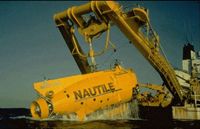 In searching vast stretches of ocean from the surface to its mountainous floor some 20,000 feet below, the technology that determines the area of the search may prove as important as that used to search it. A French nuclear submarine, the attack sub Emeraude, arrived off the coast of Brazil Wednesday to join the search for the remains of Air France Flight 447 and the aircraft’s cockpit voice and flight data recorders. Meanwhile, U.S. Coast Guard search-and-rescue experts are applying technology in Portsmouth, Va., to help identify those areas of ocean to which winds and currents may have delivered wreckage, based on the time of discovery and location of wreckage already found. The software also uses “reverse drift” technology to help determine where the items may have initially impacted the ocean. With those sets of information search areas are mapped based on their probability of containing debris. The submarine will be working with a mini-sub, the Nautile, which can descend to the ocean floor and was a key tool while searching for the Titanic. It will also be aided by U.S. underwater audio devices that authorities say can pick up signals generated from a depth of 20,000 feet. The Emeraude is expected to cover 13 square miles per day and investigators stipulate that due to complexities of the ocean floor in the search area, they’re going to need a lot of luck.
In searching vast stretches of ocean from the surface to its mountainous floor some 20,000 feet below, the technology that determines the area of the search may prove as important as that used to search it. A French nuclear submarine, the attack sub Emeraude, arrived off the coast of Brazil Wednesday to join the search for the remains of Air France Flight 447 and the aircraft’s cockpit voice and flight data recorders. Meanwhile, U.S. Coast Guard search-and-rescue experts are applying technology in Portsmouth, Va., to help identify those areas of ocean to which winds and currents may have delivered wreckage, based on the time of discovery and location of wreckage already found. The software also uses “reverse drift” technology to help determine where the items may have initially impacted the ocean. With those sets of information search areas are mapped based on their probability of containing debris. The submarine will be working with a mini-sub, the Nautile, which can descend to the ocean floor and was a key tool while searching for the Titanic. It will also be aided by U.S. underwater audio devices that authorities say can pick up signals generated from a depth of 20,000 feet. The Emeraude is expected to cover 13 square miles per day and investigators stipulate that due to complexities of the ocean floor in the search area, they’re going to need a lot of luck.
The Coast Guard’s software is called the Search and Rescue Optimal Planning System (SAROPS) and likely works best with marine-based events that include the breakup of a vessel on the water or sailors and cargo tossed off a ship at some known point. If, as investigators supsect, the Air France Airbus A330 broke up in flight and rained down parts of different shapes and densities from high speed and altitude, SAROPS will face even more challenges.


































